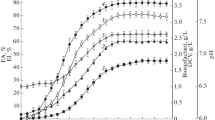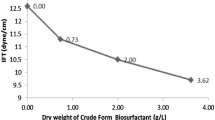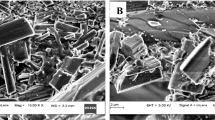Abstract
The effect of heavy metals on the activity of biosurfactants produced by Joostella strain A8 from the polychaete Megalomma claparedei was investigated. Biosurfactant activity was first improved by evaluating the influence of abiotic parameters. Higher E24 indices were achieved at 25 °C in mineral salt medium supplemented with 2 % glucose, 3 % sodium chloride (w/v) and 0.1 % ammonium chloride (w/v). Considerable surface tension reduction was never recorded. Heavy metal tolerance was preliminarily assayed by plate diffusion method resulting in the order of toxicity Cd > Cu > Zn. The activity of biosurfactants was then evaluated in the presence of heavy metals at different concentrations in liquid cultures that were incubated under optimal conditions for biosurfactant activity. The production of stable emulsions resulted generally higher in the presence of metals. These findings suggest that biosurfactant production could represent a bacterial adaptive strategy to defend cells from a stress condition derived from heavy metals in the bulk environment.






Similar content being viewed by others
References
Amoozadeh E, Malek E, Rashidinejad R, Nabavi S, Karbassi M, Ghayoumi R, Ghorbanzadeh-Zafarani G, Salehi H, Sures B (2014) Marine organisms as heavy metal bioindicators in the Persian Gulf and the Gulf of Oman. Environ Sci Pollut Res Int 21:2386–2395
Bodour AA, Guerrero-Barajas C, Jiorle BV, Malcomson ME, Paull AK, Somogyi A, Trinh LN, Bates RB, Maier RM (2004) Structure and characterization of flavolipids, a novel class of biosurfactants produced by Flavobacterium sp. strain MTN11. Appl Environ Microbiol 70:114–120
Das P, Mukherjee S, Sen R (2009) Biosurfactant of marine origin exhibiting heavy metal remediation properties. Bioresour Technol 100:4887–4890
De Souza MJ, Nair S, Loka Bharathi PA, Chandramohan D (2006) Metal and antibiotic-resistance in psychrotrophic bacteria from Antarctic marine waters. Ecotoxicology 15:379–384
De Troch M, Cnudde C, Willems A, Moens T, Vanreusel A (2010) Bacterial colonization on fecal pellets of harpacticoid copepods and on their diatom food. Microb Ecol 60:581–591
Du Z, Zhang W, Xia H, Lü G, Chen G (2010) Isolation and diversity analysis of heterotrophic bacteria associated with sea anemones. Acta Oceanol Sin 29:62–69
Dupont S, Carre-Mlouka A, Domart-Coulon I, Vacelet J, Bourguet-Kondracki ML (2014) Exploring cultivable Bacteria from the prokaryotic community associated with the carnivorous sponge Asbestopluma hypogea. FEMS Microbiol Ecol 88:160–174
Dyksterhouse SE, Gray JP, Herwig RP, Lara JC, Staley JT (1995) Cycloclasticus pugetii gen. nov., sp. nov., an aromatic hydrocarbon-degrading bacterium from marine sediments. Int J Syst Bacteriol 45:116–123
Frąc M, Oszust C, Lipiec J (2012) Community level physiological profiles (CLPP), characterization and microbial activity of soil amended with dairy sewage sludge. Sensors 12:3253–3268
Gutierrez T, Rhodes G, Mishamandani S, Berry D, Whitman WB, Nichols PD, Semple KT, Aitken MD (2014) polycyclic aromatic hydrocarbon degradation of phytoplankton-associated Arenibacter spp. and description of Arenibacter algicola sp. nov., an aromatic hydrocarbon-degrading bacterium. Appl Environ Microbiol 80:618–628
Hameed A, Shahina M, Lin SY, Lai WL, Liu YC, Hsu H, Cheng C, Young CC (2014) Robertkochia marina gen. nov., sp. nov., of the family Flavobacteriaceae, isolated from surface seawater, and emended descriptions of the genera Joostella and Galbibacter. IJSEM 64:533–539
Hara A, Radin NS (1978) Lipid extraction of tissues with a low-toxicity solvent. Anal Biochem 90:420–426
ISO 5509 (2000). Animal and vegetable fats and oils In: Preparation of Methyl Esters of Fatty Acids
Jackson SA, Kennedy J, Morrissey JP, O’Gara F, Dobson ADW (2012) Pyrosequencing reveals diverse and distinct sponge-specific microbial communities in sponges from a single geographical location in Irish waters. Microb Ecol 64:105–116
Khopade A, Biao R, Liu X, Mahadik K, Zhang L, Kokare C (2012a) Production and stability studies of the biosurfactant isolated from marine Nocardiopsis sp. B4. Desalination 285:198–204
Khopade A, Ren B, Liu XY, Mahadik K, Zhang L, Kokare C (2012b) Production and characterization of biosurfactant from marine Streptomyces species B3. J Colloid Interface Sci 367:311–318
Kim BC, Lee KH, Kim MN, Jung MY, Chang YH, Lee J, Shin KS (2011) Joostella atrarenae sp. nov., a novel member of the Flavobacteriaceae originating from the black sea sand of Jeju Island. Curr Microbiol 62:606–611
Kiran SG, Anto T, Selvin J, Sabarathnam B, Lipton AP (2010) Optimization and characterization of a new lipopeptide biosurfactant produced by marine Brevibacterium aureum MSA13 in solid state culture. Bioresour Technol 101:2389–2396
Lakshmipathy TD, Prasad ASA, Kannabiran K (2010) Production of biosurfactant and heavy metal resistance activity of Streptomyces sp. VITDDK3—a novel halo tolerant actinomycetes isolated from saltpan soil. Adv Biol Res 4:108–115
Licata P, Trombetta D, Cristani M, Martino D, Naccari F (2004) Organochlorine compounds and heavy metals in the soft tissue of the mussel Mytilus galloprovincialis collected from Lake Faro (Sicily, Italy). Environ Int 30:805–810
Lo Giudice A, Caruso C, Mangano S, Bruni V, De Domenico M, Michaud L (2012) Marine bacterioplankton diversity and community composition in an Antarctic coastal environment. Microb Ecol 63:210–223
Lotfabad TB, Shourian M, Roostaazad R, Najafabadi AR, Adelzadeh MR, Noghabi KA (2009) An efficient biosurfactant-producing bacterium Pseudomonas aeruginosa MR01, isolated from oil excavation areas in south of Iran. Colloids Surf B Biointerfaces 69:183–193
Maneerat S, Bamba T, Harada K, Kobayashi A, Yamada H, Kawai F (2006) A novel crude oil emulsifier excreted in the culture supernatant of a marine bacterium, Myroides sp. strain SM1 Appl. Microbiol Biotechnol 70:254–259
Quan ZX, Xiao YP, Roh SW, Nam YD, Chang HW, Shin KS, Rhee SK, Park YH, Bae JW (2008) Joostella marina gen. nov., sp. nov., a novel member of the family Flavobacteriaceae isolated from the East Sea. Int J Syst Evol Microbiol 58:1388–1392
Rizzo C, Michaud L, Hörmann B, Gerçe B, Syldatk C, Hausmann R, De Domenico E, Lo Giudice A (2013) Bacteria associated with Sabellids (Polychaeta: Annelida) as a novel source of surface active compounds. Mar Pollut Bull 70:125–133
Rizzo C, Michaud L, Syldatk C, Hausmann R, De Domenico E, Lo Giudice A (2014) Influence of salinity and temperature on the activity of biosurfactants by polychaete-associated isolates. Environ Sci Pollut Res 21:2988–3004
Rocha CA, Pedregosa AM, Laborda F (2011) Biosurfactant-mediated biodegradation of straight and methyl-branched alkanes by Pseudomonas aeruginosa ATCC 55925. AMB Express 1:9
Satpute SK, Bhawsar BD, Dhakephalkar PK, Chopade BA (2008) Assessment of different screening methods for selecting biosurfactant producing marine bacteria. Indian J Mar Sci 37:243–250
Selvin J, Priya SS, Kiran GS, Thangavelu T, Bai NS (2009) Sponge-associated marine bacteria as indicators of heavy metal pollution. Microbiol Res 164:352–363
Singh P, Cameotra SS (2004) Potential applications of microbial surfactants in biomedical sciences. Trends Biotechnol 22:142–146
Stackebrandt E, Chertkov O, Lapidus A, Nolan M, Lucas S, Han C, Cheng J-F, Tapia R, Goodwin LA, Bruce D, Pitluck S, Liolios K, Mavromatis K, Pagani J, Ivanova N, Mikhailova N, Huntemann M, Pati A, Chen A, Palaniappan K, Rohde M, Tindall BJ, Göker M, Woyke T, Detter JC, Bristow J, Eisen JA, Markowitz V, Hugenholtz P, Klenk H-P, Kyrpides NC (2013) High-quality-draft genome sequence of the yellow-pigmented flavobacterium Joostella marina type strain (En5T). Stand Gen Sci 8:37–46
Tuleva B, Christova N, Jordanov B, Jordanov B, Nikolova-Damyanova B, Petrov P (2005) Naphthalene degradation and biosurfactant activity by Bacillus cereus 28BN. Z Naturforsch C 60(577):582
Velmurugan N, Kalpana D, Cho JY, Lee GH, Park SH, Lee YS (2011) Phylogenetic analysis of culturable marine bacteria in sediments from South Korean Yellow Sea. Microbiology 80:261–272
Yang X, Li X, Zhou Y, Zheng W, Yu C, Zheng T (2014) Novel insights into the algicidal bacterium DH77-1 killing the toxic dinoflagellate Alexandrium tamarense. Sci Total Environ 482–483:116–124
Acknowledgments
The authors wish to thank Rossana Rando (Department of Environmental Science, Safety, Territory, of Food and Health, University of Messina) for fatty acid analysis, and Giuseppe Sabatino (Department of Earth Sciences and Physics, University of Messina) for SEM analysis.
Conflict of interest
The authors declare that they have no conflict of interest.
Author information
Authors and Affiliations
Corresponding author
Rights and permissions
About this article
Cite this article
Rizzo, C., Michaud, L., Graziano, M. et al. Biosurfactant activity, heavy metal tolerance and characterization of Joostella strain A8 from the Mediterranean polychaete Megalomma claparedei (Gravier, 1906). Ecotoxicology 24, 1294–1304 (2015). https://doi.org/10.1007/s10646-015-1504-y
Accepted:
Published:
Issue Date:
DOI: https://doi.org/10.1007/s10646-015-1504-y




